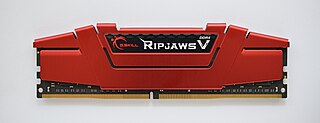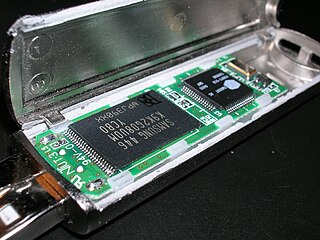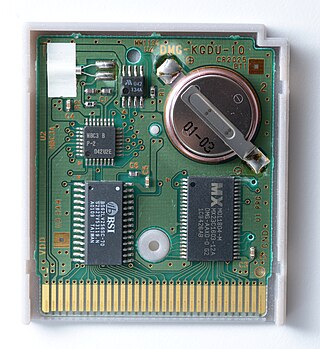Related Research Articles

Computer data storage or digital data storage is a technology consisting of computer components and recording media that are used to retain digital data. It is a core function and fundamental component of computers.

Computer memory stores information, such as data and programs, for immediate use in the computer. The term memory is often synonymous with the terms RAM,main memory, or primary storage. Archaic synonyms for main memory include core and store.

Flash memory is an electronic non-volatile computer memory storage medium that can be electrically erased and reprogrammed. The two main types of flash memory, NOR flash and NAND flash, are named for the NOR and NAND logic gates. Both use the same cell design, consisting of floating gate MOSFETs. They differ at the circuit level depending on whether the state of the bit line or word lines is pulled high or low: in NAND flash, the relationship between the bit line and the word lines resembles a NAND gate; in NOR flash, it resembles a NOR gate.

EEPROM or E2PROM (electrically erasable programmable read-only memory) is a type of non-volatile memory. It is used in computers, usually integrated in microcontrollers such as smart cards and remote keyless systems, or as a separate chip device, to store relatively small amounts of data by allowing individual bytes to be erased and reprogrammed.
A RAM drive is a block of random-access memory that a computer's software is treating as if the memory were a disk drive. RAM drives provide high-performance temporary storage for demanding tasks and protect non-volatile storage devices from wearing down, since RAM is not prone to wear from writing, unlike non-volatile flash memory. They are in a sense the reverse of virtual memory: RAM drive uses a volatile fast memory as if it's a nonvolatile slow memory. Virtual memory is the opposite.
Non-volatile random-access memory (NVRAM) is random-access memory that retains data without applied power. This is in contrast to dynamic random-access memory (DRAM) and static random-access memory (SRAM), which both maintain data only for as long as power is applied, or forms of sequential-access memory such as magnetic tape, which cannot be randomly accessed but which retains data indefinitely without electric power.
Wear leveling is a technique for prolonging the service life of some kinds of erasable computer storage media, such as flash memory, which is used in solid-state drives (SSDs) and USB flash drives, and phase-change memory. There are several wear leveling mechanisms that provide varying levels of longevity enhancement in such memory systems.

A flash drive is a data storage device that includes flash memory with an integrated USB interface. A typical USB drive is removable, rewritable, and smaller than an optical disc, and usually weighs less than 30 g (1 oz). Since first offered for sale in late 2000, the storage capacities of USB drives range from 8 megabytes to 256 gigabytes (GB), 512 GB and 1 terabyte (TB). As of 2023, 2 TB flash drives were the largest currently in production. Some allow up to 100,000 write/erase cycles, depending on the exact type of memory chip used, and are thought to physically last between 10 and 100 years under normal circumstances.
In computing, mass storage refers to the storage of large amounts of data in a persisting and machine-readable fashion. In general, the term "mass" in "mass storage" is used to mean "large" in relation to contemporaneous hard disk drives, but it has also been used to mean "large" relative to the size of primary memory as for example with floppy disks on personal computers.

Magnetic storage or magnetic recording is the storage of data on a magnetized medium. Magnetic storage uses different patterns of magnetisation in a magnetizable material to store data and is a form of non-volatile memory. The information is accessed using one or more read/write heads.
Reading is an action performed by computers, to acquire data from a source and place it into their volatile memory for processing. Computers may read information from a variety of sources, such as magnetic storage, the Internet, or audio and video input ports. Reading is one of the core functions of a Turing machine.
Semiconductor memory is a digital electronic semiconductor device used for digital data storage, such as computer memory. It typically refers to devices in which data is stored within metal–oxide–semiconductor (MOS) memory cells on a silicon integrated circuit memory chip. There are numerous different types using different semiconductor technologies. The two main types of random-access memory (RAM) are static RAM (SRAM), which uses several transistors per memory cell, and dynamic RAM (DRAM), which uses a transistor and a MOS capacitor per cell. Non-volatile memory uses floating-gate memory cells, which consist of a single floating-gate transistor per cell.
Digital permanence addresses the history and development of digital storage techniques, specifically quantifying the expected lifetime of data stored on various digital media and the factors which influence the permanence of digital data. It is often a mix of ensuring the data itself can be retained on a particular form of media and that the technology remains viable. Where possible, as well as describing expected lifetimes, factors affecting data retention will be detailed, including potential technology issues.
An in-memory database is a database management system that primarily relies on main memory for computer data storage. It is contrasted with database management systems that employ a disk storage mechanism. In-memory databases are faster than disk-optimized databases because disk access is slower than memory access and the internal optimization algorithms are simpler and execute fewer CPU instructions. Accessing data in memory eliminates seek time when querying the data, which provides faster and more predictable performance than disk.
Write once read many (WORM) describes a data storage device in which information, once written, cannot be modified. This write protection affords the assurance that the data cannot be tampered with once it is written to the device, excluding the possibility of data loss from human error, computer bugs, or malware.

Ferroelectric RAM is a random-access memory similar in construction to DRAM but using a ferroelectric layer instead of a dielectric layer to achieve non-volatility. FeRAM is one of a growing number of alternative non-volatile random-access memory technologies that offer the same functionality as flash memory. An FeRAM chip contains a thin film of ferroelectric material, often lead zirconate titanate, commonly referred to as PZT. The atoms in the PZT layer change polarity in an electric field, thereby producing a power-efficient binary switch. However, the most important aspect of the PZT is that it is not affected by power disruption or magnetic interference, making FeRAM a reliable nonvolatile memory.

Read-only memory (ROM) is a type of non-volatile memory used in computers and other electronic devices. Data stored in ROM cannot be electronically modified after the manufacture of the memory device. Read-only memory is useful for storing software that is rarely changed during the life of the system, also known as firmware. Software applications, such as video games, for programmable devices can be distributed as plug-in cartridges containing ROM.
This glossary of computer hardware terms is a list of definitions of terms and concepts related to computer hardware, i.e. the physical and structural components of computers, architectural issues, and peripheral devices.
Solid-state storage (SSS) is non-volatile computer storage that has no moving parts; it uses only electronic circuits. This solid-state design dramatically differs from the commonly-used competing technology of electromechanical magnetic storage which uses moving media coated with magnetic material. Generally, SSS is much faster but more expensive for the same amount of storage.

The memory cell is the fundamental building block of computer memory. The memory cell is an electronic circuit that stores one bit of binary information and it must be set to store a logic 1 and reset to store a logic 0. Its value is maintained/stored until it is changed by the set/reset process. The value in the memory cell can be accessed by reading it.
References
- ↑ Patterson, David; Hennessy, John (2005). Computer Organization and Design: The Hardware/Software Interface. Elsevier. p. 23. ISBN 9780080502571.
- ↑ "i-NVMM: Securing non-volatile memory on the fly". Techrepublic . August 2011. Archived from the original on 22 March 2017. Retrieved 21 March 2017.
- ↑ "Non-Volatile Memory (NVM)". Techopedia. Archived from the original on 22 March 2017. Retrieved 21 March 2017.
- ↑ Russell Kay (7 June 2010). "Flash memory". ComputerWorld. Archived from the original on 10 June 2010.
- ↑ F-RAM Memory Technology, Ramtron.com, archived from the original on 27 January 2012, retrieved 30 January 2012
- ↑ The Emergence of Practical MRAM "Crocus Technology | Magnetic Sensors | TMR Sensors" (PDF). Archived from the original (PDF) on 27 April 2011. Retrieved 20 July 2009.
- ↑ "Latest News". EE|Times. Archived from the original on 19 January 2012.
- ↑ Hudgens, S.; Johnson, B. (November 2004). "Overview of Phase-Change Chalcogenide Nonvolatile Memory Technology". MRS Bulletin. 29 (11): 829–832. doi:10.1557/mrs2004.236. ISSN 1938-1425. S2CID 137902404.
- ↑ Pirovano, A.; Lacaita, A.L.; Benvenuti, A.; Pellizzer, F.; Hudgens, S.; Bez, R. (December 2003). "Scaling analysis of phase-change memory technology". IEEE International Electron Devices Meeting 2003. pp. 29.6.1–29.6.4. doi:10.1109/IEDM.2003.1269376. ISBN 0-7803-7872-5. S2CID 1130884.
- ↑ Lee, H. Y.; Chen, P. S.; Wu, T. Y.; Chen, Y. S.; Wang, C. C.; Tzeng, P. J.; Lin, C. H.; Chen, F.; Lien, C. H.; Tsai, M. J. (2008). Low power and high speed bipolar switching with a thin reactive Ti buffer layer in robust HfO2-based RRAM. 2008 IE
- ↑ "Definition: tape drive". TechTarget. Archived from the original on 7 July 2015. Retrieved 7 July 2015.
- ↑ "Tape Drives". snia.org. Archived from the original on 7 July 2015. Retrieved 7 July 2015.
- ↑ "What is hard drive?". computerhope.com. Archived from the original on 8 July 2015. Retrieved 7 July 2015.
- ↑ "IBM 2314 Disk Drives". ncl.ac.uk. Archived from the original on 2 October 2015. Retrieved 7 July 2015.
- ↑ "Optical Blu-ray Jukeboxes and Libraries Systems for Archiving Storage – Kintronics". kintronics.com. Archived from the original on 20 July 2015. Retrieved 7 July 2015.
- ↑ Parkin, Stuart S. P.; Hayashi, Masamitsu; Thomas, Luc (11 April 2008). "Magnetic Domain-Wall Racetrack Memory". Science. 320 (5873): 190–194. Bibcode:2008Sci...320..190P. doi:10.1126/science.1145799. PMID 18403702. S2CID 19285283.
- ↑ Thinfilm and InkTec awarded IDTechEx' Technical Development Manufacturing Award IDTechEx, 15 April 2009
- ↑ PolyIC, ThinFilm announce pilot of volume printed plastic memories Archived 29 September 2012 at the Wayback Machine EETimes, 22 September 2009
- ↑ All set for high-volume production of printed memories Archived 13 April 2010 at the Wayback Machine Printed Electronics World, 12 April 2010
- ↑ "NVDIMM – Changes are Here, So What's Next?" (PDF). snia.org. SINA . Retrieved 24 April 2018.
- ↑ Kannan, Sachhidh; Karimi, Naghmeh; Sinanoglu, Ozgur; Karri, Ramesh (22 January 2015). "Security Vulnerabilities of Emerging Nonvolatile Main Memories and Countermeasures". IEEE Transactions on Computer-Aided Design of Integrated Circuits and Systems. 34 (1): 2–15. doi:10.1109/TCAD.2014.2369741. S2CID 14712674 – via IEEE Xplore.